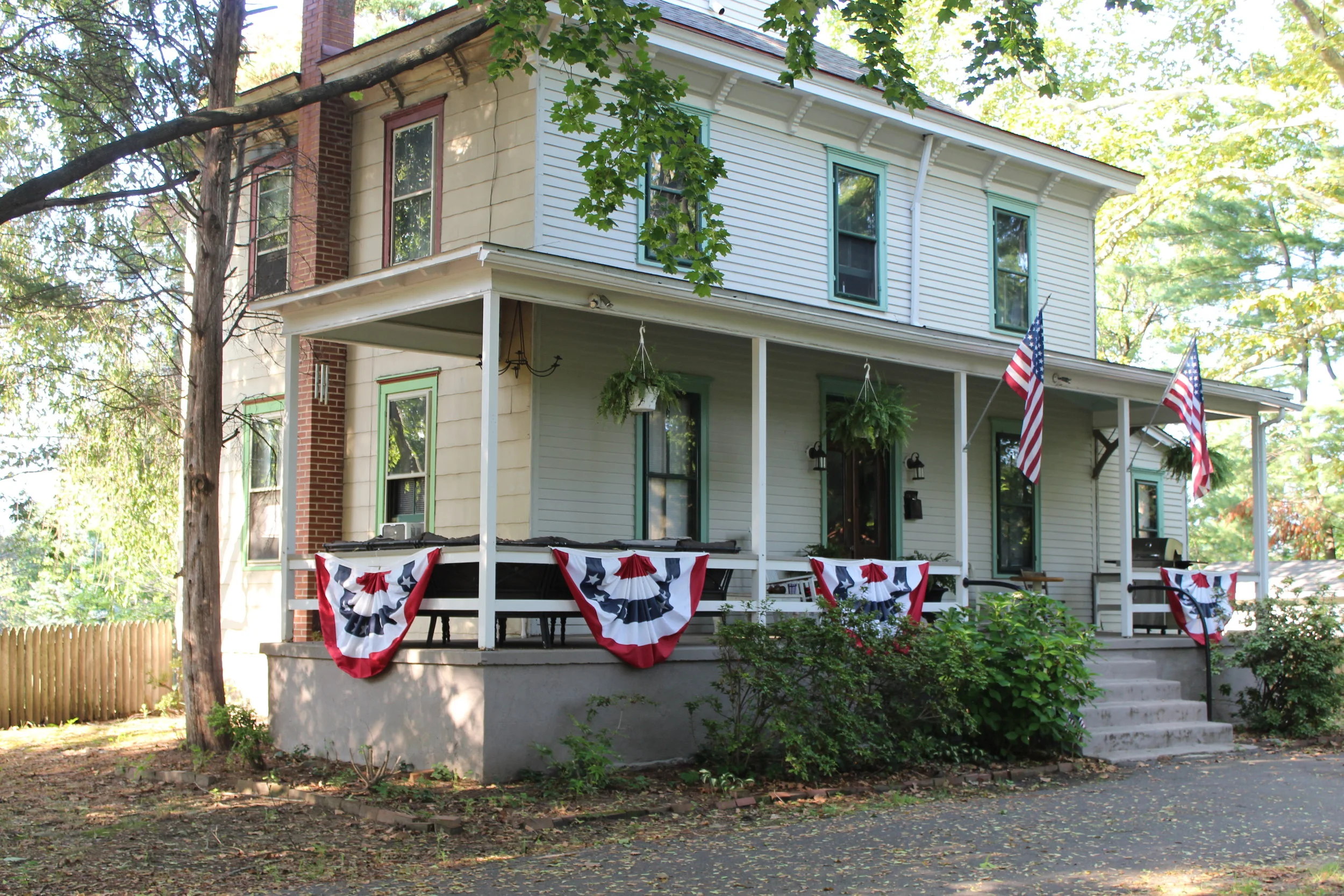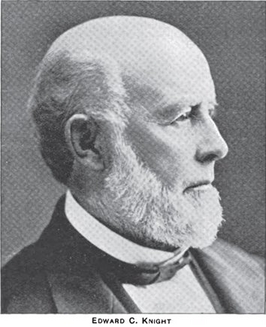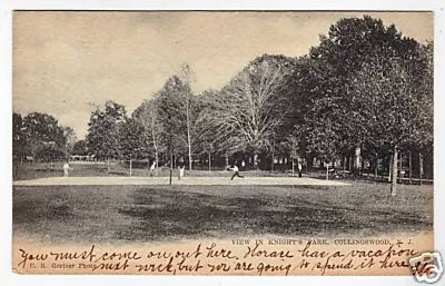HISTORY OF KNIGHT PARK
In the 1880’s, the largest landowner in Collingswood—Edward C. Knight—was not only an acclaimed Philadelphia businessman, but was also a generous donor to his hometown. In 1888, Knight dedicated about 70 acres of his land to use as a park in Collingswood, which we know and love as Knight Park. Growing up on the corner of Collings Avenue and Browning Road, Knight resided in what is now known as Collings-Knight House. Knight Park is the epicenter of Collingswood Borough, acting as a microcosm for its park-goers. It has served as a space for soccer, baseball, and field hockey players to practice and play, featured many live musical performances in which the community has gathered and listened to their favorite tunes under the setting sun, and been a place of solace for those who simply want to relax on the grass or under a tree. It’s safe to say that Knight Park is a jewel in the center of one of South Jersey’s most beloved classic towns.
Knight Park is the second park to be developed on the triangular farm field bordered by Park and Collings Avenues and Browning Road, following only the Collingswood Land Company development established by Edward C. Knight in 1887. The plan, such as it was, featured a looping road around the perimeter of the land with several entrances from the surrounding streets. Originally, the area was a large field which the 1887 New Jersey Topographic map shows had a small cedar swamp at the center where the lakes were later formed. In anticipation of the construction of a park, Mr. Knight’s superintendent, Richard T. Collings, planted the whole field in wheat which served as a nurse crop to provide cover for a seeding of grass.
“The park comprises about 70 acres, and is one broad expanse of velvety lawn, in the center of which is an inviting grove of umbrageous oak trees. Near by a large pavilion capable of accommodating perhaps 300 people is being erected and is now on the verge of completion. (Over near the edge of the grounds is being erected a park house, a portion of which will be occupied by the superintendent of grounds).”
–West Jersey Press, August 22, 1888
All this feverish activity during July and August 1888 was leading up to the formal dedication of Knight Park by E. C. Knight, who would continue its operation as an integral part of his Collingswood Land Company. The dedication was held on Saturday, August 18, 1888 under the auspices of the Methodist Episcopal Church Harvest Home.
“Last week Mr. Knight sent out five hundred park benches to be used by the multitude who will gather there at the opening next Saturday.”
–West Jersey Press, August 15, 1888
“The opening of this destined-to-become popular resort was attended with much interest. Mr. Knight, with a party of friends was present, and took a lively interest in the occasion. There were athletic sports in the afternoon, and the Camden City Band discoursed excellent music. Fully 600 people took supper in the pavilion in the evening. Much of the success in arranging the park is due Mr. Richard T. Collings, who looks after Mr. Knight’s interest in this place.”
–West Jersey Press, August 22, 1888
As the 1880’s gave way to the 1890’s the popularity of the park continued to grow. For the 1889 summer season a fine baseball field was constructed and by 1890 an H.K. Barrett had opened a refreshment stand in the park.
On July 21, 1892 Edward C. Knight died in Cape May, New Jersey following an illness of several months. It is with Knight’s death that the second stage in the development of the park began. In a very brief will, Mr. Knight appointed his widow, Anna M, his son, Edward, Jr., and his daughter, Anna C. as executors of the will and trustees of his estate. Among their very early acts was to legally establish Knight Park as a memorial to Edward C. Knight’s father and mother by appointing a committee of seven trustees. The president of the group was Edward C. Knight, Jr., who continued in this capacity until his death in 1936. The deed conveying the park land to the trustees was recorded May 13, 1893. The park was formally dedicated a second time in the spring of 1893. In addition to the gift of the ground the Knight family donated $100,000 to keep the property in good condition. The entire gift was valued at $250,000.
“Fully 3,000 persons were present at the dedication ceremonies of Knight Park, Collingswood, held on Friday, last. The weather was all that could have been desired for the holding of outdoor exercises, and the occasion will be long remembered by those who were present.”
–West Jersey Press, May 19, 1893
Following the dedication the new trustees were formally organized in E.C. Knight, Jr’s. office in Philadelphia. Richard T. Collings was designated as Superintendent of Knight Park and an administrative committee to meet monthly was designated. E.C. Knight was the chairman of both the trustees and the executive committee. Within the year Mr. Knight engaged the services of Alfred R. Egerton, civil engineer and landscape architect, to prepare a master plan and direct the reconstruction of a new park. The rules for the park were based largely on those for Fairmount Park in Philadelphia.
The first year of work consisted of laying drainage tile through most of the park and the removal of the 1887 drive around the edge of the park. The work appears to have been broken into two three-year phases in which new roads were laid, regrading of the field to break its flatness, the sodding of road sides, and the seeding of lawns was completed. A striking new feature of the plan was the construction of small lakes to replace the cedar swamp which showed on the first topographic map of the state in 1887. Bridges were constructed to carry roads and walks over the water. Boat landings were constructed along the shores.
Although the Knight family had provided an endowment for the park’s upkeep, it was necessary for E.C. Knight, Jr. to loan the park the funds necessary to implement the landscape architect’s plans. By 1900 the improvements were largely completed.
During the first two decades of the twentieth century, the park came into its own. Postcards from that date exist in some quantity that reveal what a handsome place Knight Park was. The lakes were filled with boats; elaborate bridges spanned the waterways and flowering trees and shrubs seemed everywhere. The only apparent problems were the drying up and stagnancy of the lakes in the late summer.
A careful examination of the minutes of the Park reveal, however, that even as early as 1910 the maintenance costs of keeping the park in top order taxed the actual proceeds of the Knight Endowment. The financial situation was made even tighter by the long term repayment to Edward C. Knight, Jr. of his advances for the park’s development. By the late 1920’s the town commissioners, were dismayed by what they felt was a deterioration in the park’s upkeep. In 1930 a special enabling bill was presented to and passed by the State Assembly which made possible the acceptance of municipal funds for use in maintaining Knight Park. This legislation remains in effect today and Knight Park is the only park in New Jersey to be supported in such a way. As the years have gone by the Borough has assumed an increasingly important role in the maintenance and upkeep of the park.
–From “Knight Park” by George Palmer and Peter Childs, Collingswood Centennial Book, 1988
KNIGHT PARK—POST 1936
Knight Park Today
With the death of Edward C. Knight, Jr. in 1936, there was no further participation by any member of the Knight or Collings family in the management of the Park. H. Wilbur Bircks, a member of the Trustees since 1920, became president of the Trustees and thereafter managed the park until his death in 1966.
Mr. Bircks’ assumption of the management of the park continued the downward spiral of activities which had been evident for more than the past ten years. The income from the trust established by Edward C. Knight’s estate in 1893 had proved inadequate to operate the park as early as 1915. Edward C. Knight, Jr.’s will created a trust for the park’s benefit, but the park would not participate therein until after the death of all of Mr. Knight’s children, which in fact did not occur for an additional 45 years. Mr. Bircks had no option therefore but to continue the termination of most of the particular recreational functions previously provided in the park. The park’s tennis courts were eliminated. Horseback riding, a popular recreational activity, had to be discontinued because there were insufficient funds to maintain the horses. Boating on the park lake was discontinued because the park could no longer afford the necessary insurance. The road bridges over the lake were torn down, the last bridge to remain being replaced by a pedestrian walkway. Ice skating on the lake during the winter is no longer permitted.
Shortly after Mr. Bircks’ death, the park was no longer able to continue to pay the salary of the Park Superintendent. So that the trustees could continue to have someone at the park to manage maintenance, the Borough of Collingswood agreed to put the Superintendent on its payroll. With the retirement of the last Superintendent, Carl Jubb, in 2011, the Borough was unable to continue doing this and the park has not had a Superintendent.
In later years, recreational and sports activities have resumed in the park, but those activities are managed by the Little League, for baseball, the School District, for baseball and field hockey, and the Borough for soccer and various other sports and recreational activities.
Subsequent park presidents, Walter Marshall, Robert Scarborough, Arthur Armitage, Jr., James Perrin and currently Michael Brennan have continued to manage the park. Since 1981, the park has been the recipient of the income from the trust created by the Estate of Edward C. Knight and by the will of Edward C. Knight, Jr. The park has also been the beneficiary of generous gifts from Mr. Scarborough, the estate of Mr. Marshall and from Dr. Frederick Van Istendal. The Trustees are very grateful for these gifts, which form its capital, and for current gifts which add to income, but the income from the capital fund created by those gifts rarely exceeds $20,000 and enables the trustees only to provide necessary insurance, perform simple maintenance and replace some of the park’s magnificent trees.
Despite the lack of necessary income, the trustees have, with the cooperation and support of the Borough, been able to provide a considerable amount of recreational activity throughout the year, featuring various sports, movie nights and band concerts. The Borough has also been of great assistance in scheduling some important maintenance projects, including road repair and tree trimming. Through current gifts and the management of assets, the trustees have been able to construct a blacktop walking path around two sides of the perimeter of the Park and also dredge the lake. The Collingswood Board of Education has recently funded a road restoration project along Collings Avenue to arrest bank erosion along the roadway. Knight Park, the finest asset of the Borough of Collingswood, continually needs the attention and support of its citizens so that much more could usefully be done.
–James Perrin, Knight Park Trustee, 2013





